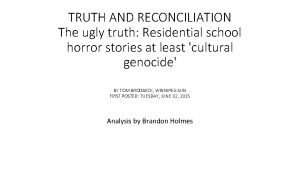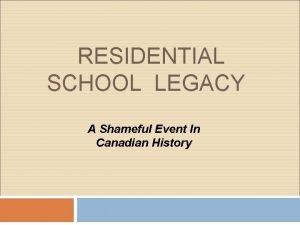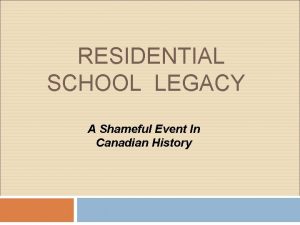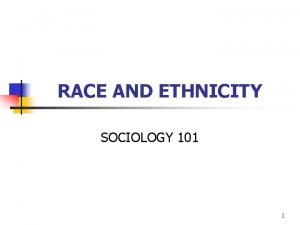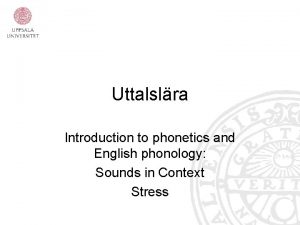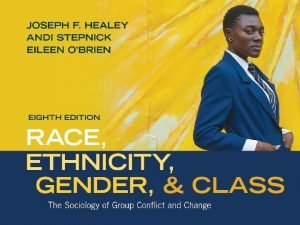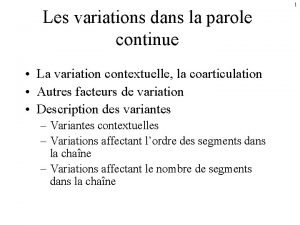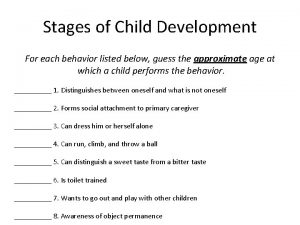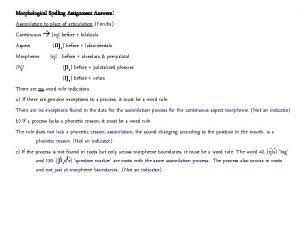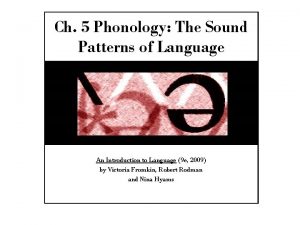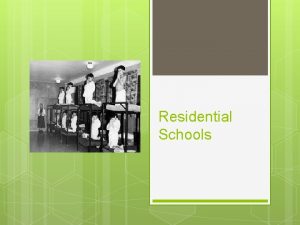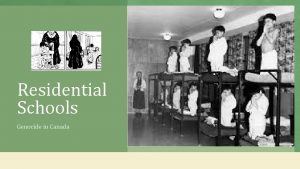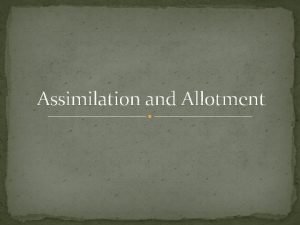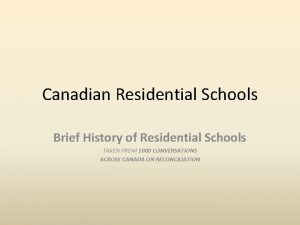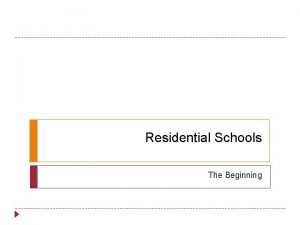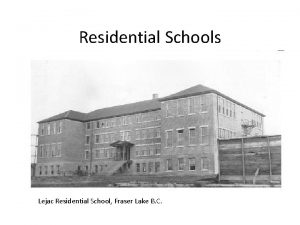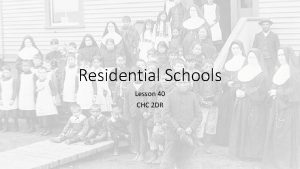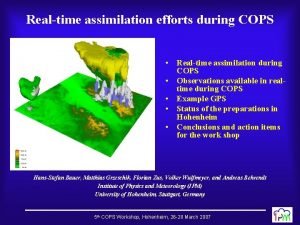Assimilation Residential Schools Late 1800 1996 Residential Schools





















- Slides: 21

Assimilation: Residential Schools Late 1800 - 1996

Residential Schools: Lesson Goals • Understand reasons behind the creation of residential schools • Explain the structure of residential schools (ex. A day in the life of a native student) • Identify the effects of the residential school system on the lives of those who attended • Describe church and government efforts to make amends to residential school abuses (psychological, physical and sexual)


Distribution of Residential Schools in Canada

Remember the role of missionairies? • They were sent by the church (either Catholic or Protestant) to the New World to convert lost Aboriginal souls to Christianity. This had damaging effects on Aboriginal peoples who suffered assimilation, abandonment of traditional beliefs, forced conversion and misunderstanding of Christian teachings, etc.

Residential Schools: A continuation of religious assimilation … and more. • The Canadian government and the church operated residential schools (the government funded them $$$ and the church ran them). • Keep in mind, the federal government was responsible for financing education for First Nations who were considered ‘wards of the state’.

Who would willingly allow their kids to go to residential school? • Many First Nations fully support the idea that their children should go to school and receive an education in order to ensure that their cultures survived in a changing world. • But residential schools removed children from their reserve, family home, culture, language and way of life to live at school where the government could further its objectives: assimilation.

Structure of Residential Schools • All aspects of First Nations culture were eliminated from residential schools. Children were forbidden to speak their native language and punished for doing so. • Boys segregated from girls, and siblings were separated in an effort to weaken family ties • They wore school uniforms instead of traditional clothing. Hair was cut short – European style. And they are primarily Euro-Canadian foods.

• Celebrated Christian holidays. Learned European sports (ex. Soccer and Cricket) • Day was divided between religious instruction and training for manual labor. Children were taught practical skills like sewing, woodworking, reading, and writing (rather than academic subjects like history, geography, math, and science) VIDEO CLIP: “A new future” http: //archives. cbc. ca/society/education/topics/692/

Notes: How does the structure of residential schools differ from today’s schools?

Problems: Abuse at Residential School These schools were the source of the many problems and concerns: • They were breeding grounds for potentially fatal diseases like smallpox and tuberculosis. • Students were not allowed to practice Aboriginal customs or speak Aboriginal languages. Punishable physically. • They were poorly maintained to the point of posing serious safety and other health hazards.

• They were the source of great animosity between the government and Aboriginal parents who refused to let their children be taken away from them. • They were poorly equipped to properly clothe students, particularly during the winter months. • They were source of dangerous fires often deliberately set by problem children.

• The food served at these schools were particularly lacking in nutritional value. • The work was physically demanding and harsh on the students. • Teachers were often so ill equipped that they could not teach students much beyond completely alien religious ideologies. • They were the source of great absenteeism, on both the students and teachers' parts alike. (Some students would even run away. )

In fact, many historians feel these schools were responsible for grooming children who would grow up with various social behavioral problems. Many blame this failure on government underfunding and disinterest or Aboriginal resistance. Although the government would increase funding to these schools in the 1950 s, they had finally come under intense public scrutiny. Oneby-one, they were closed. The last school of its type finally closed in 1996. VIDEO: Native leader charges church with abuse, 1990 http: //archives. cbc. ca/society/education/topics/692/

Whistle Blower: Dr. Peter Bryce In 1907, Dr. Peter Bryce, former Medical Inspector for the Department of Indian Affairs, determined that between 25 and 50 % of Aboriginal students who attended these schools died as a result of disease (namely tuberculosis or “TB”), raciallymotivated abuse or some other reason. NOTHING WAS DONE. THESE STATISTICS WERE NOT AVAILABLE TO THE PUBLIC/MEDIA. AND IT COST DR. BRYCE HIS CAREER.

Results? NOTHING WAS DONE. THESE STATISTICS WERE NOT AVAILABLE TO THE PUBLIC/MEDIA. AND IT COST DR. BRYCE HIS CAREER.

Impact of Residential Schools • During the school year, students were not allowed to have contact with families and communities. Even during vacations they were not reunited with their families. • As a result, children had little or no contact with their families for many years.

Notes: How do you think they felt when they DID return home?

Cultural Genocide • The mass extermination of a people’s culture and way of life was done through residential schools. • Even today the effects are seen: Children who attended residential schools were deprived of family life and did not learn how to raise children themselves! • This gap in parenting is a key reason from societal problems in Aboriginal communities (ex. Spousal and child abuse, violence, alcoholism, and suicide).

How would you feel if you were separated from you family for an extended period of time? How do you think this would effect your relationship with you family if you were away for many years?

Video: TRUTH AND RECONCILIATION (TRC) – INTERNATIONAL CENTRE OF TRANSITIONAL JUSTICE - YOUTH VIDEO http: //www. trc. ca/websites/trcinstitution/index. php? p=513 A Formal Apology from the Prime Minister Video: A long-awaited apology 2008
 Residential schools horror stories
Residential schools horror stories Before and after residential schools
Before and after residential schools Residential schools
Residential schools Tuberculosis in residential schools
Tuberculosis in residential schools Residential school photos show legacy erasure
Residential school photos show legacy erasure Residential schools canada
Residential schools canada Map of residential schools in canada
Map of residential schools in canada Powerschool hsv
Powerschool hsv Safety target reach schools
Safety target reach schools Assimilation culture
Assimilation culture Celebrate recovery lesson 14
Celebrate recovery lesson 14 Regressive assimilation examples
Regressive assimilation examples Pluralism and assimilation
Pluralism and assimilation Villi adaptation
Villi adaptation Assimilation in digestion
Assimilation in digestion L'assimilation phonétique
L'assimilation phonétique Dissimilation rules
Dissimilation rules Data assimilation
Data assimilation Data assimilation
Data assimilation Example of assimilation in child development
Example of assimilation in child development Assimilation exercises with answers
Assimilation exercises with answers Segment insertion and deletion rules
Segment insertion and deletion rules
